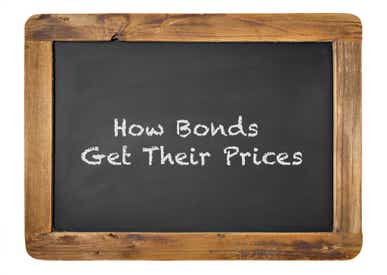Coupon and Zero-Coupon Bond Pricing Explained

Coupon and Zero-Coupon Bond Pricing Explained
Bond price in the secondary market is affected by the time to maturity, the credit risk, and market demand and supply
A bond’s price reflects the present value of its cash flow stream, which consists of the periodic coupon payments and the final principal repayment.
The bond price is obtained by discounting the expected cash flows using an appropriate discount rate, which reflects the opportunity cost of investing in the bond. The main factors that affect the bond price in the secondary market are the time to maturity, the credit risk, market demand and supply.
Par value explained
Every bond has a par value, which is the amount that will be paid at maturity. The bond can trade at par, above par, or below par, depending on the market price relative to the par value. The coupon rate is the fixed annual interest rate that is applied to the par value to determine the coupon payments. The current yield is the ratio of the annual coupon payment to the market price, which varies inversely with the bond price.
A bond trades at par when its market price equals its par value. A bond trades at a premium when its market price exceeds its par value, and trades at a discount when its market price is below its par value. For example, a bond with a par value of $1,000 and a market price of $1,100 is trading at a premium. On the other hand, a bond with a par value of $1,000 and a market price of $900 is trading at a discount.
Valuing coupon bonds
The coupon payments of a bond are fixed, but the current yield changes with the bond price. A lower bond price implies a higher current yield, making the bond more attractive to investors, ceteris paribus. For example, a bond with a par value of $1,000 and a coupon rate of 5% pays $50 in annual interest regardless of its market price. When the bond’s market price is $900, its current yield is 5.6%.
The value of a coupon bond is the present value of its future cash flows, which include the coupon payments and the principal repayment at maturity. To calculate the value of a coupon bond, you need to know the coupon rate, the face value, the yield to maturity, and the number of periods until maturity. The formula for the value of a coupon bond is:
Price = C * [1 - 1/(1 + YTM)^n] / YTM + F / (1 + YTM)^n
Where:
- C is the periodic coupon payment
- F is the face value or par value of the bond
- YTM is the yield to maturity or required rate of return
- n is the number of periods until maturity
For example, suppose you want to find the value of a bond that pays a 5% annual coupon, has a face value of $1,000, matures in 10 years, and has a yield to maturity of 7%. You can use the formula to get:
- Price = $50 * [1 - 1/(1 + 0.07)^10] / 0.07 + $1,000 / (1 + 0.07)^10 Value = $50 * 5.582 / 0.07 + $1,000 / 1.967
- Price = $398.86 + $508.35
- Price = $907.21
This means that the bond is worth $907.21 today, which is lower than its face value because its yield to maturity is higher than its coupon rate.
Valuing zero-coupon bonds
A zero-coupon bond is a type of bond that does not pay any interest to the investor. Instead, it is sold at a lower price than its face value, and the investor receives the face value when the bond matures. The value of a zero-coupon bond depends on how much it will pay in the future, and how much interest rate the investor requires.
The formula for calculating the price of a zero-coupon bond is:
Price = F / (1 + r)^n
Where:
- F is the face value or maturity value of the bond
- r is the required interest rate or yield of the bond
- n is the number of years until the bond matures
For example, suppose you want to buy a zero-coupon bond that has a face value of $1,000 and will mature in 10 years. If you require an interest rate of 5% per year, you can use the formula to find the price of the bond:
- Price = $1,000 / (1 + 0.05)^10
- Price = $1,000 / 1.629
- Price = $613.91
This means you can buy the bond for $613.91 today and receive $1,000 in 10 years. The difference between the price and the face value is your profit or return from investing in the bond.
Christopher Vecchio, CFA, tastylive’s head of futures and forex, has been trading for nearly 20 years. He has consulted with multinational firms on FX hedging and lectured at Duke Law School on FX derivatives. Vecchio searches for high-convexity opportunities at the crossroads of macroeconomics and global politics. He hosts Futures Power Hour Monday-Friday and Let Me Explain on Tuesdays, and co-hosts Overtime, Monday-Thursday. @cvecchiofx
For live daily programming, market news and commentary, visit tastylive or the YouTube channels tastylive (for options traders), and tastyliveTrending for stocks, futures, forex & macro.
Trade with a better broker, open a tastytrade account today. tastylive, Inc. and tastytrade, Inc. are separate but affiliated companies.
Options involve risk and are not suitable for all investors. Please read Characteristics and Risks of Standardized Options before deciding to invest in options.